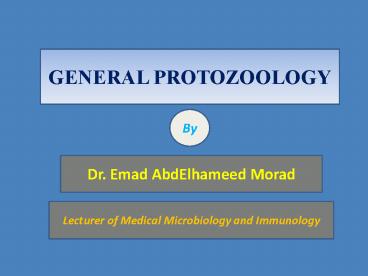GENERAL PROTOZOOLOGY PowerPoint PPT Presentation
1 / 12
Title: GENERAL PROTOZOOLOGY
1
GENERAL PROTOZOOLOGY
By
Dr. Emad AbdElhameed Morad
Lecturer of Medical Microbiology and Immunology
2
Protozoa are
- Unicellular organisms.
- Structurally equivalent to a single cell.
- But, functionally, equal to a whole animal as it
can perform all functions of life. - Each cell is formed of a mass of protoplasm
which is differentiated into
Cytoplasm
Nucleus
3
Cytoplasm
- Cytoplasm is differentiated into ectoplasm and
endoplasm. - Protection from the surrounding environment.
- Locomotion motility of the cell may occur by
pseudopodia, cilia and flagellae.
Outer thin hyaline layer
Ectoplasm
4
- Nutrition by absorption of nutrients or ingestion
of solid particles by the help of pseudopodia or
cytosome. - Respiration through diffusion of gases (aerobic
and anaerobic). - Excretion through diffusion through the body or
by excretory vacuoles.
5
- Food vacuoles for digestion of food.
- Excretory vacuoles discharging waste products
to exterior. - Volutin granules stored food in the form of
carbohydrates (glycogen vacuoles) or protein
(chromatoid bodies).
Inner granular layer
Endoplasm
6
Nucleus
- Made of nuclear membrane and chromatin which
represent the genetic material of the cell (DNA
or RNA). - The chromatin is present in a single mass called
karyosome and also distributed on the inner
surface of nuclear membrane (peripheral
chromatin). - In some protozoa, chromatin is present diffusely
through out the nucleus.
7
Reproduction
- Asexual
- Simple division of the nucleus and cytoplasm
into two parts (binary fission) or several parts
(multiple fission). - Sexual
- Formation of male and female gametes by meiosis
and their union to form zygote.
8
Classification
- According to the organs of locomotion
- Class rhizopoda
- Move by pseudopodia (false legs).
- Example amoeba.
9
- Class ciliates
- Move by cilia which are small thin filaments
found on the entire surface of the cell. - Example Balantidium coli.
10
- Class Flagellates
- Move by flagellae which are thin whip like
filaments that arise from inside the cell. - According the habitat
- Intestinal such as Giardia lamblia.
- Urogenital such as Trichomonas vaginalis.
- Blood such as leishmania and trypanosoma.
11
- Class sporoza
- Move by gliding.
- Examples
- Plasmodium cause malaria.
- Coccidia cause diseases such as toxoplasmosis.
12
GOOD LUCK

